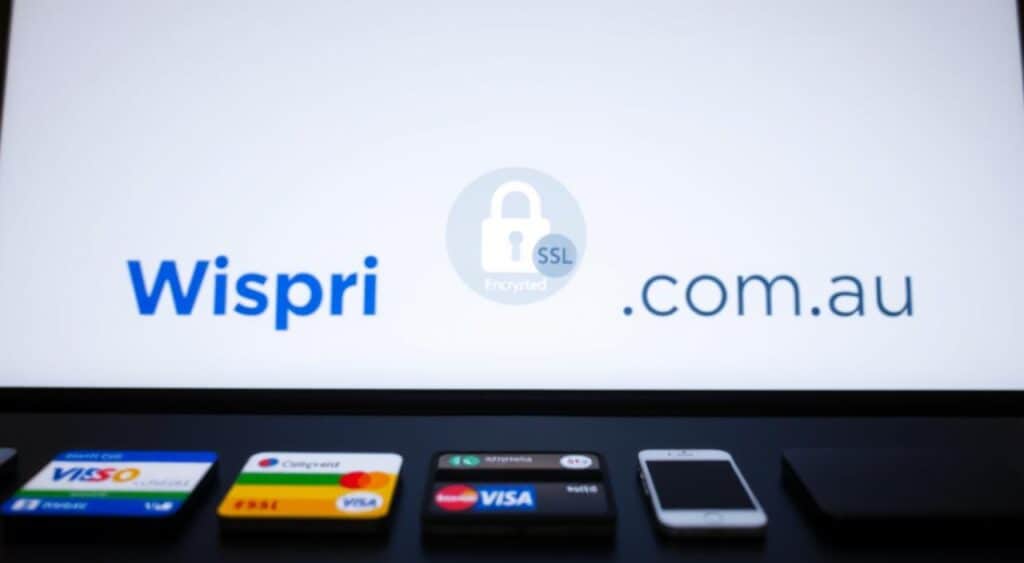Australians lose millions yearly to cleverly disguised traps in the digital marketplace. Did you know fake stores selling everyday items like phones, gym gear, or kids’ toys drain wallets faster than a busted tap? These scammers create polished websites and social media profiles, mimicking trusted retailers to trick bargain hunters.
Even savvy shoppers get caught. Why? Fake “sales” often pressure you with countdown timers or limited stock alerts. That urgent deal on a new BBQ set? It might vanish – along with your money – if you act without checking.
Manual price tracking leaves you exposed. Spending hours comparing deals across stores? Fraudsters exploit that effort, offering “discounted” prices on cloned sites. Tools like Wispri remove the guesswork by monitoring genuine price drops automatically.
This guide reveals how modern cons work – from fake review tactics to payment methods designed to disappear. You’ll learn simple verification steps and how tech can shield your budget while still snagging real bargains.
Key Takeaways
- Fake sales on everyday items drain Aussie households yearly
- Urgency tactics pressure shoppers into rushed decisions
- Manual price checks increase exposure to cloned stores
- Trusted tracking tools provide safer deal alerts
- Scammers exploit popular product categories repeatedly
- Payment methods can reveal shady sellers early
Understanding Online Shopping Scams in Australia
Digital tricksters are draining Aussie bank accounts through fake deals you’d swear were real. These cons have moved beyond basic copycat sites to complex schemes that exploit trust in familiar platforms.

Evolving Fraud Methods
Criminals now create mirror versions of popular store websites, right down to the copyright details. One mum nearly lost $800 on a pram that showed “in stock” on a cloned baby goods site. “They even used our real return policy wording,” admits a JB Hi-Fi spokesperson.
Marketplace manipulation has become alarmingly sophisticated. Check this comparison:
| Feature | Scam Sites | Legit Retailers |
|---|---|---|
| Payment Options | Only bank transfers | Secure gateways |
| Contact Details | Generic email | Verified phone/address |
| Social Proof | Fake review clusters | Diverse review history |
Cybercrime Pattern Shifts
Recent ACCC data shows 43% of fraud now starts through social media ads. Scammers target specific groups – new parents see formula deals, gamers get “discounted” consoles. Payment diversion scams increased 67% last year, where altered invoices send money to criminal accounts.
“Fraudsters now spend weeks building fake seller profiles before striking” – Australian Cyber Security Centre 2024 Report
Legitimate price trackers like those monitoring Amazon AU and Bunnings provide transparent historical data. This helps spot sudden “discounts” that don’t match real market trends.
Recognising the Warning Signs
Criminals have become alarmingly good at hiding red flags in plain sight. Before clicking “buy,” watch for subtle inconsistencies that separate genuine retailers from digital traps.
Spotting Fake Websites and Cloned Stores
Real businesses always display contact details and legal policies. If a site lacks a physical address or uses a generic @gmail.com email, walk away. Check the URL carefully – scammers often use domains like “bestbuystore-au.net” instead of official addresses.
Secure sites show HTTPS and a padlock icon during checkout. Tools like Wispri add another layer of protection by flagging unrealistic price drops. As one cybersecurity expert notes: “Fraudulent discounts often appear 30-50% below market averages – numbers that should make any savvy buyer pause.”
Identifying Suspicious Payment and Contact Requests
Legit retailers never demand bank transfers or cryptocurrency. Watch for sellers pushing communication to personal messaging apps or asking for sensitive details upfront. A recent ACCC report found 78% of shopping scam victims were pressured into paying through unsecured channels.
Always verify contact methods before purchasing. Reputable companies use professional email formats (e.g., [email protected]) and provide phone verification. When in doubt, search the business name + “reviews” to uncover potential warnings from other buyers.
Online Shopping Scams: What to Look Out For
Your next great deal could be a digital minefield. Popular platforms like Facebook Marketplace, Gumtree, and eBay host genuine buyers and sellers, but also sophisticated cons that exploit trust in peer-to-peer transactions.

Marketplace Dangers on Facebook, Gumtree, and eBay
Watch for profiles with stolen photos and sudden spikes in positive reviews. One Aussie nearly lost $2,500 on a campervan listing where the seller claimed to be “overseas for work” – a common excuse to avoid meeting in person. Always check:
- Account creation dates (new profiles = higher risk)
- Consistent transaction history across multiple items
- Physical meetup willingness for local buying selling
Fake Sellers, Overpayment Tricks, and Invoice Redirection
Fraudulent buyers might send fake payment confirmations, then demand refunds for “accidental overpayments”. Last month, a Sydney woman lost $1,800 after accepting a PayID screenshot that later proved doctored. “Scammers bank on your urgency to complete the order,” explains a NSW Fraud Squad detective.
Three red flags in marketplace ads:
- Prices 40% below retail averages
- Requests to communicate via WhatsApp or Telegram
- Last-minute payment detail changes
“Always call the business directly using publicly listed numbers to confirm invoice changes – email alone isn’t proof.” – Australian Competition and Consumer Commission
Tools like Wispri’s AI-powered tracking help spot these traps by comparing prices across 200+ legitimate retailers. If a Marketplace deal seems too good, check its social media footprint against verified store data first.
How to Protect Yourself When Shopping Online
Guarding your wallet starts with smarter checkout habits. Criminals target payment details and weak account security – but simple changes to your routine can block most threats.

Secure Payment Methods and Account Safety
Always choose credit cards or services like PayPal at checkout. These let you dispute charges if goods never arrive. Avoid direct bank transfers – once sent, that money’s gone. A recent ASIC report found 92% of fraud victims used debit cards or instant payment apps.
Set transaction alerts on every account. Spotting unauthorised charges early helps freeze damage. Tools like Wispri PRO add extra layers by cross-checking store reputations before you pay. Their free version still flags high-risk sellers using real-time data.
Using Strong Passwords and Verifying Retailer Legitimacy
Create unique passwords for each store – mixing letters, numbers, and symbols. Never reuse banking logins elsewhere. Check sites have HTTPS encryption and physical addresses listed. One Melbourne shopper avoided a fake tech store by verifying their ABN matched official records.
Type website URLs manually instead of clicking ads. This simple step bypasses most phishing traps. As cybersecurity expert Dr. Emma Tan notes: “Scammers clone checkout pages perfectly – but they can’t fake a business’s registration documents.”
Leveraging AI-Powered Price Monitoring with Wispri
Smart price tracking tools are becoming essential armour against digital deception. Wispri cuts through fake deals by analysing real pricing data from trusted Australian retailers. This platform lets you verify offers in seconds, turning price history into your personal scam filter.
Features of Wispri for Smart Shoppers
Wispri’s AI scans 200+ stores like Bunnings and JB Hi-Fi daily. The dashboard shows price trends over months, exposing sudden “discounts” that don’t match market patterns. Historical data reveals if a product ever sold at its claimed original price – scammers hate this transparency.
| Feature | Free Version | Wispri PRO |
|---|---|---|
| Retailers Tracked | 50+ Major Stores | 200+ Including Marketplaces |
| Price History Depth | 6 Months | 3 Years |
| Custom Alerts | 3 Products | Unlimited Items |
Benefits of Customisable Price Drop Alerts
Set your target price for any item – from BBQs to laptops – and get notified only when legit stores meet it. No more rushing into shady “limited-time offers”. One user saved $420 on a washing machine by waiting for Wispri’s verified alert at Harvey Norman.
The system cross-checks multiple retailers simultaneously. If a deal seems too good true, it’ll flag mismatches against historical averages. As cybersecurity expert Liam Chen notes: “Consistent pricing data is kryptonite to fraudsters’ fake discount tactics.”
With real-time tracking and scam-resistant alerts, you’re not just saving money – you’re shopping with armour-plated confidence.
Step-by-Step Guide to Avoid Online Shopping Scams
Staying safe while hunting deals requires both caution and quick action. Arm yourself with these practical steps to spot fakes and respond effectively if things go sideways.
Smart Checks Before You Click Buy
Always verify a seller’s credentials. Search their business name + “ABN lookup” to confirm registration details. Check physical address maps and call the listed number – real stores answer during business hours.
Review multiple platforms for consistency. A genuine retailer has matching info across their website, social media, and directories. For pricey goods, use secure payment methods like credit cards that offer purchase protection.
Act Fast If Something Feels Off
Report suspicious activity immediately. Contact the platform where you saw the scam and submit details to ScamWatch. If you shared personal data, call IDCARE’s free support line (1800 595 160) – they’ll help secure your accounts.
Change passwords for any compromised service immediately. Forward fake invoices to [email protected] – this helps authorities track criminal patterns. Bookmark trusted websites like the ACCC’s scam hub for ongoing updates.
Remember: genuine sellers welcome questions. If a deal pressures you to skip checks, walk away. Your vigilance is the ultimate bargain protector.

